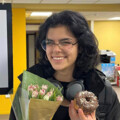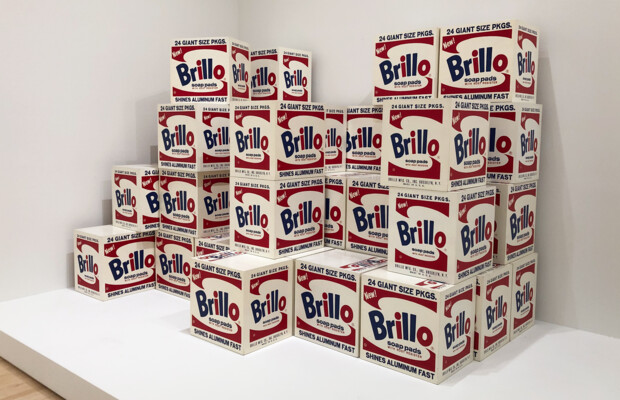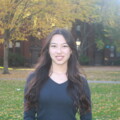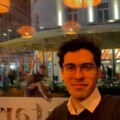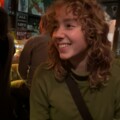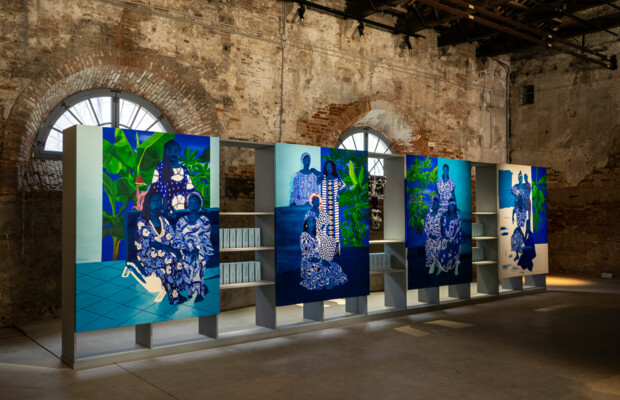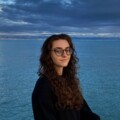Amsterdam Curators to Watch in 2024
What is curatorship? What are its challenges? How does one start off? Four Amsterdam-based curators - Thom Oosterhof, Rita Ouédraogo, Amine Hanouche, and Manon Awilo - open up about their experience as curators.
What is curatorship? What are its challenges? How does one start off? Four Amsterdam-based curators - Thom Oosterhof, Rita Ouédraogo, Amine Hanouche, and Manon Awilo - open up about their experience as curators.
Art is subjective, seen through everyone’s own individual lens. Nevertheless, each lens is carefully guided by curators - those who keep, handpick, and oversee art exhibitions. Which artists are to be displayed? Where are their artworks to be placed in the room? What narrative would the artworks portray once perceived as a whole? Curators are the force that guides us to answer these questions.
In a city like Amsterdam, saturated with vibrant art and creative spaces, four curators opened up about their experiences, with an intention to shed light on what being a curator is like. Curators Thom Oosterhof, Rita Ouédraogo, Amine Hanouche, and Manon Awilo, each have their own interests, drive, and career aspirations.
Thom Oosterhof is a New Zealand-born and Amsterdam-based collector and curator who organises exhibitions internationally. He recently curated shows in Barcelona, London, and Italy, as well as multiple in Amsterdam. Thom was inspired to start curating by his passion for art and interest in bringing attention to the emerging contemporary art scene. He stays close to this drive by including young art graduates’ works in his projects. Oosterhof’s exhibitions tend to revolve around themes he wishes to bring to people’s attention, such as ‘our relationship to time’ or ‘affection through the lenses of light and dark’. He has no plans to open his own gallery but hopes to create an international community that appreciates “young contemporary art”.

Rita Ouédraogo is the curator of Buro Stedelijk in Amsterdam. With a background in anthropology, she explores how art, in all its differing forms, can question power structures, institutions as powerhouses, institutional racism and other systems that we live in and live by. She is interested in experimentation, collaboration and solidarity as a starting point for programming, curating, writing, and her ongoing research into these themes. Ouédraogo inspects the boundaries of expression. Recent exhibitions that the curator produced at the Buro Stedelijk are ‘Descent into Fungal’ and ‘TRUTH’. However, Rita’s work goes beyond the Buro Stedelijk, as she also curates in other spaces in the city.

Manon Awilo is a creative consultant with experience in music curation, who has recently curated her first art exhibition ‘In a Box’. Her entire life, she has been close to visual arts, working with artists since 2020. The aim of her projects so far has been to guide people towards a deeper appreciation of art and induce reflection on the boxes and limitations forced onto individuals by society.

Amine Hanouche is a young curator working in Amsterdam. Driven by his interest in art, Hanouche started by curating for friends, gaining some recognition along the way. However, his career truly took off after winning ‘Tender Stenen Hoofd’: a pop-up restaurant competition organized by the Amsterdam municipality. In the exhibition, he brought together art and food – matching artworks to foods, characteristics of artists’ backgrounds, culinary preferences, or creative expressions. He is now aiming to open his own space where the youth can explore art through food in a relaxed environment.

What is curatorship?
Curatorship is such an individual practice, defining which is a difficult task in itself. “It is very personal,” says Rita, “I think for everybody this might be a little different.” The unique approach that each curator brings to their art has a direct impact on how they describe their profession. Rita’s sentiment is shared by the other curators, who described their tasks with colourful imagery of their personal experiences. The methods employed by the four are indicative of the deep thought and reflection process that goes into their profession.

Amine describes curatorship as solving a big puzzle. “I like to describe it as making one big thing match up,” he says, “It doesn’t have to be perfect, because that could be nice as well. But it has to fit and it has to match.” He specifies that “matching” can take place in many different ways, yet the work of a curator is to make sure that the chosen combination works.
The curator thus chooses the presentation of the artworks, as well as the lens through which viewers will perceive an exhibition. Thom expresses how his position allows him to show people what he wants them to see. “I’m trying to say something, you know?” he explains, “trying to bring light to a certain theme or a certain idea that I think is worth acknowledging.” Still, Oosterhof’s focus is not only limited to the theme and message of the exhibition but also to the artists exhibited there. Thom, for example, emphasises the value he gives to exhibiting works of young art school graduates: “I am so in awe of their ambition and their fearlessness in becoming an artist.”
Nevertheless, being a curator is more than just choosing the aesthetic presentation of the exhibition. Manon uses the very particular imagery of gardening to express this aspect of the job. “Curating, for me, is like agriculture” she says, “A curator is someone that has the tools and wants to grow a garden.” She explains that a lot of research needs to go into understanding how to take care of the metaphorical seeds. She states that her role as a gardener is “to show all that I discover in the research and to have the audience appreciate it.”
That’s how I would describe curation: it’s staying tapped into the creative universe, to be always very aware of what’s happening around me.
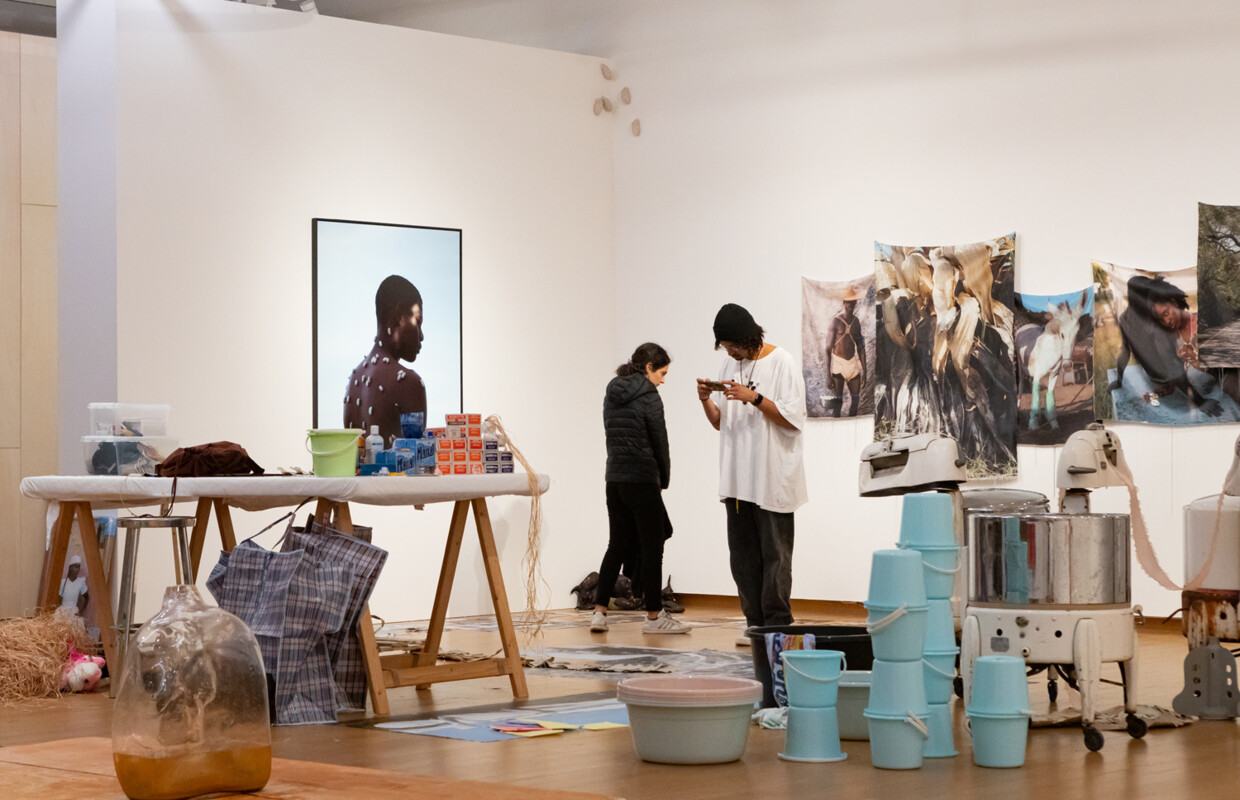
Manon also highlights the importance of cooperation in the curatorial process. She says “I want people to understand my condition. But if I want people to understand my condition, I need to understand theirs.” This sentiment is strongly mirrored by Rita, who defines curatorship mostly as a process of listening. “If I think about curation and how I would like or how I like to curate, it’s a lot of listening,” she says, “inviting others to step into this arena where they can be vulnerable and where you are then also vulnerable, together.” Rita then expands on this stating that the curatorial process is never individual, but rather a collective aim of working on an exhibition together. She acknowledges that there is a hierarchy, and whoever curates is calling the shots, but it cannot be achieved alone: “You're not just envisioning something, writing it down and then leaving it with somebody else, but you're there, and you're experiencing this space, the works; and you're taking care of the works and the space. In that way, you also take care of the people you work with and invite others into this.”
What are the challenges of curatorship?
Similarly to establishing a definition of curatorship, the challenges curators face are also very subjective - both to the curator and to the exhibition they are working on, since all shows are different, as well as the obstacles that come with them. “You are always dealing with different situations and different needs and different people and therefore you also have to be receptive to what they might need or want,” Rita explains. However, this challenge can be overcome by staying responsive and communicating with the team.

Additionally, some curators, like Amine, find that the unpredictability of an exhibition’s outcome can become a challenge. “It’s always a risk because maybe people won’t come,” he says, “but at the same time it can be a bit much, or grow too quickly.” Dealing with the outcome of a project can thus challenge a curator.
Nevertheless, there are other unpredictable aspects which can challenge the curatorial process. Thom describes the drawbacks to a project that occur when the predicted route is not achievable, such as when an artist is not willing or available to participate. “If an artist that I’m really excited to work with isn’t available I get a little bit stuck,” he details, “especially if there is a cool connection that would then build a part of the show.”
There are also more technical challenges that can occur. Thom, for example, regards shipping as a difficulty: “I stepped away from that pretty quickly. It just breaks your heart if something gets damaged, but it’s a real part of the industry.” Rita, on the other hand, found technical challenges in maintaining certain exhibitions, as she had experiences with Mycelium - a type of fungi - or placing a pool in the centre of the space.
Throughout the curatorial process, however, none of the curators found that the challenge was held in the artistic course itself. “You have to stay consistent and you have to stay focused, not taking anything for granted,” says Manon, “but it’s not a challenge because I like it.” The curators’ passion for art and the environment drives them to tackle any challenge they encounter along the way.
Establishing connections with artists
A large aspect of curatorship is dependent on collaboration with artists and institutions. The establishment of connections to these is described as “rather straightforward”.

Thom and Amine both proceed with the mentality of ‘just asking’. “What has helped in my journey is not really being bothered about failing,” says Thom. Especially at the beginning of his career, Thom explains how he just “rolled the dice” and hoped for artists to reply and be interested in working together. Similarly, Amine describes “If I like someone’s art I literally just text them or go to the gallery and ask for contacts.”
Manon expresses that one has to be more insistent when it comes to networking: “You have to really chase people, you have to go for what you want.” At the same time, she highlights the importance of feeling aligned with an artist when building connections. “I would say a connection in terms of aligning your vision and the way you work’,” she says, “otherwise it doesn’t work.” In terms of connecting with galleries, Thom builds on this sentiment, stating “I think it’s important that I work with galleries that share the same values and have the same ideas around young contemporary art.”

When talking about securing collaborations via networking, Rita emphasises the importance of establishing a sincere connection: “I’ve visited a lot of exhibitions, and had a lot of studio visits… You build relationships with people and if I’m interested in something then I keep working on this relationship.” She explains how sometimes the collaboration does not come immediately but grows as the relationship does. “That might be something that grows over the years or might not happen right away, but it’s because you are interested in each other’s practices and you see what’s happening and what’s ongoing.”
Curators Thom Oosterhof, Rita Ouédraogo, Amine Hanouche, and Manon Awilo demonstrate how curatorship extends beyond the arrangement of artworks. Instead, it is an artistic practice rooted in attentive listening, continuous growth, and an openness to change. Despite the challenges inherent in the profession, it is fueled by an unwavering passion for the arts and their impact on society.
Share the post:
